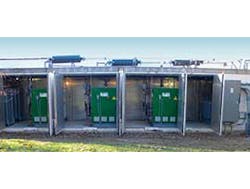Combined Heat and Power Systems Subject to Marketplace Growth
In Part 3 of this five-part series, author Ed Ritchie defines how Combined Heat and Power (CHP) Systems can produce measurable electricity savings in business energy management. Whether prompted by technological advancements, diversity in CHP systems options or a reduction in cost and implementation, onsite CHP systems are promoting utility savings and returning distributed energy benefits in commercial applications. Industry examples cited below are utilizing energy saving programs and reaping the rewards of improved energy efficiency.
Business Energy Provides a Sound Strategy for Peak Shaving & Power Security (Part Three) By Ed Ritchie
As equipment designs for CHP get more sophisticated and less expensive, industry analysts expect steady growth for the marketplace, thus bringing CHP closer to mainstream status. According to a report from Transparency Market Research, the market for distributed energy technologies including CHP, solar photovoltaic, wind turbine, and fuel cells in residential, building, institutional, and commercial applications was valued at USD 99.68 billion in 2011, and is expected to reach USD 155.86 billion in 2018, growing at a CAGR of 6.7% from 2012 to 2018. Annual DEG installation capacity was 81,875.7 MW in 2011 and is expected to reach 180,093.6 MW in 2018, growing at a CAGR of 11.9% from 2012 to 2018.
Some of that growth will come from a recent category known as micro CHP systems. These are well suited to small businesses and apartment buildings, and offer some persuasive economics. For example, a micro CHP system saved the Melrose Five Project in the Bronx, NY, $12,936 in building energy costs in its first year of operations. The heat and electricity were generated onsite with an Ecopower Micro CHP system, from Marathon Engine Systems, Troy, WI.
The payback, based on 2011 electricity prices, amounts to 7.3 years. Marathon Ecopowers systems use internal combustion engines that produce 4.7 kWh of electricity, and between 29,000 to 43,000 BTU per hour of heat. At a car wash in New Milford, CT, a demand for hot water and electricity keeps an Ecopower system running almost 24 hours a day, and provides the base operating electricity load to offset utility electricity that can run as high as 0.20 per kilowatt-hour. Gas and electricity savings topped $1,550.00 for the first operational months of January and February.
In both the Ecopower cases above, the customers purchased their CHP systems, but with a power purchase agreement (PPA) as another option, it’s possible to reduce energy costs, have no upfront capital investment, eliminate the peak pricing problem, and say goodbye to those confusing utility bills. The DoubleTree Hotel in Tarrytown, NY, took advantage of a PPA when it installed a 100-kW CHP system, owned and operated by American DG Energy. The 247-room hotel pays a discounted rate for its energy, based on a $2 million contract with a 15-year term.
In March 2013, Hilton Hotel, DoubleTree’s parent company, boosted its energy savings program to a grander scale by installing a 1.75-MW CHP plant at the Hilton New York, thereby putting distributed energy to work at Manhattan’s largest hotel. The system uses seven gas-driven generators to provide clean electricity (over 50% of the electricity demand) and 2,700 kW of heat for building operations. The system is also expected to reduce operating expenses of the building by nearly half a million dollars each year over the 20-year life of the PPA contract. Anaergia, Burlington, ON, Canada, designed, built, owns, and operates the system, and it meets criteria for the US Department of Energy’s ITC program that promotes electrical efficiency and conservation of resources through CHP systems. The project also qualifies for the New York State Energy and Development Authority (NYSERDA) program to support the energy, economic, and environmental well being of New York State.
The fact that NYSERDA is supporting distributed energy is consistent with a growing trend among state governments and federal agencies, most notably the Department of Energy (DOE) and Department of Agriculture. It’s interesting to note that in New York City, while every watt of electricity generated by distributed energy is one less watt that gets billed by local utility Con Edison, nonetheless, Con Edison has a peak load problem and pays its commercial customers at least five cents per kilowatt-hour for curtailment. The utility provides extensive help for its customers that want to take advantage of peak shaving because the need is urgent. The program shifted into overdrive during New York’s July 2013 heat wave, when the utility called upon participants of the peak-shaving program to shed load for five consecutive days.
To qualify for Con Edison’s program, a commercial customer must have the ability to shed at least 100 kW of load. That’s not much for most medium to large facilities, and it allows for quite a bit of flexibility for businesses that have a high demand for process heat. In fact, the value of heat can make a CHP system ideal for cutting back on gas consumption and mitigating peak power demand charges. For example, Durst Maltz, a malt producer in Germany, reduces its electricity load by 700 kWh with a pair of GC 357 N5 CHP units from MTU Onsite Energy, Mankato, MN. The units also produce about 1 MW of thermal energy, and by harnessing the heat to assist the plant’s huge boilers, Durst saves on natural gas consumption, giving it an overall energy efficiency rating of 90%.


